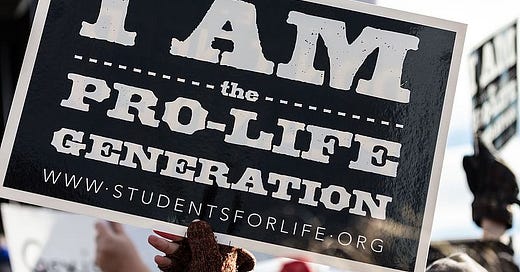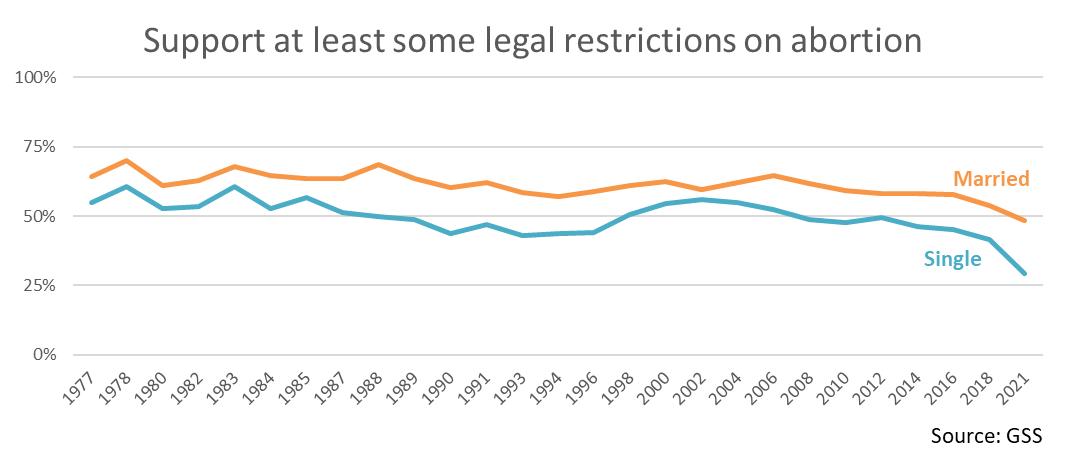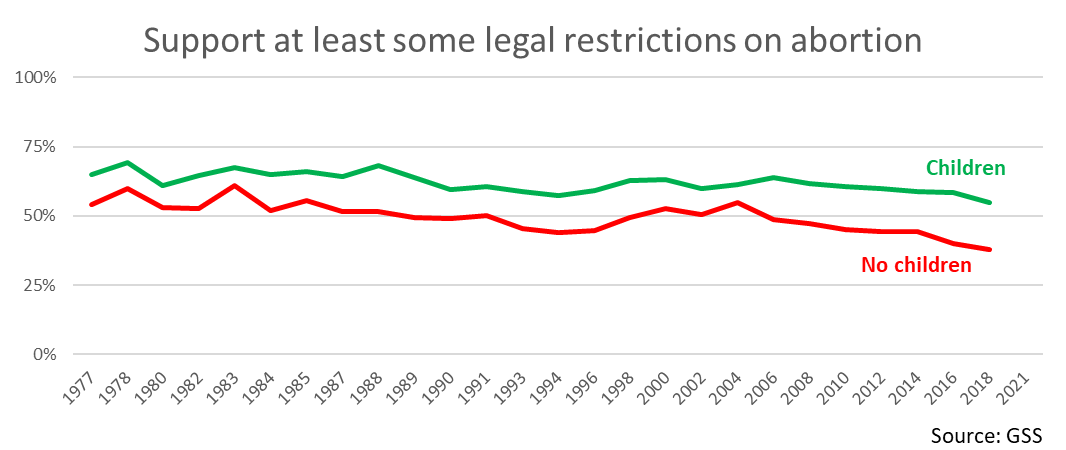
With events like the March for Life at the center, the pro-life movement in the United States has managed to maintain opposition to abortion as an active political issue, despite the five decades since the Supreme Court decided Roe v. Wade.
But support for legally restricting abortion has begun to decrease in the United States, driven by key demographic trends. And those changes suggest that pro-life political strategists may well need to change their strategies, to reach new groups, with different values, and different lifestyles than the pro-lifers of yesterday.
A look at the data makes that clear:
Since 1977, the General Social Survey has asked respondents whether it should be legal for a woman to obtain an abortion under various circumstances, including most broadly: “If the woman wants it for any reason.”
The percentage of respondents who say they oppose unfettered legal access to abortion on demand, for any reason, has gradually decreased from a high of 67% in 1978.
And in 2021, it dropped below 50% for the first time since the survey began, with 44% of respondents favoring restrictions on abortion.
Support for restricting legal access to abortion has historically been similar between men and women, with support for legal restrictions averaging about two percent higher among women.
Although there are not significant differences in support for restricting abortion between men and women, there are significant differences which align with religious practice and political parties.
Those who go to church once a week or more average 28% more likely to support restricting abortion on demand than those who go less than once a year.
When Roe v. Wade was decided in 1973, Democrats and Republicans were equally likely to support legal restrictions on abortion. But since the late 1980s support for restricting abortion has polarized significantly along political lines.
Republicans have become slightly more likely to support restricting abortion, and Democrats are much less willing to limit abortion in any way than they once were. Independents have, perhaps predictably, charted a middle course.
Two less often discussed demographic divisions have significant correlations with people’s support for restricting abortion.
Married people are significantly more willing to restrict abortion on demand than are people who have never been married. The marriage gap is larger for women than for men, but nonetheless significant for both men and women.
People who have children are also significantly more likely to support legal restrictions on abortion than those who have no children.
Pro-lifers may see clear reasons why members of these demographic groups would be more open to providing legal protection to unborn children.
Those who have gone through the process of having children know intimately the reality of life both before and after birth. And despite whatever challenges they may face in rearing children, they recognize that parenting is not an impossible burden.
Married people know that they have the support of a permanently committed partner to help in the rearing of their children.
But parenthood, marriage, and frequent church attendance are all becoming less common, particularly among younger Americans. And that leads to the declining number of Americans who oppose restrictions on abortion.
As pro-life advocates seek to build a culture of life, both in law and in practice, it will become increasingly important for them to gain the support of people who perhaps do not look like the majority of those who currently support restricting abortion.
A larger percentage of younger generations of Americans are single, do not have children, or do not attend church often. Pro-life advocates will need the support of some of those people in order to pass laws which will protect the lives of unborn children. That will likely require new strategies and new approaches — which might soon be on display at events like the March for Life.
They will also need to help build a culture of life among those people, a culture in which the idea of marriage and of having children is not alarming. And if true conversion is to be achieved, a culture in which attending church to worship the Creator of all life has a place as well.














I have spent alot of time in Ireland over the years, including in the run-up to the referendum legalizing abortion. Most observers believe that the rapid transition of Ireland from a nation that embedded additional pro-life protections in its constitution with popular support to one that moved to full legalization in a generation was tied to collapse of the authority of the Church on moral matters.
Now the troubles of the Catholic Church in Ireland are sadly multiple and long-lasting, but when it comes to its loss of moral authority I would argue it stems to a large extent from its entanglement, both by necessity and as policy, with the government of an independent Ireland. The Church had close relations with the two party duopoly that ruled Ireland after independence and was able to play an important role not only in policy but also in the provision of education and other welfare services.
That allowed them to accomplish much good, but meant that when the Celtic Tiger imploded and the political establishment that the Church had become entangled with was spectacularly discredited (especially Fianna Fail, which as the dominant party always tried to stay onside with the Church) the Church's moral authority was crippled. True, it was already under attack for a variety of scandals but many of those scandals were a unique outgrowth of its quasi-state sponsored services -- the abuses committed in Church run borstals, schools and homes for unwed mothers were arguably just as much a function of a poor country underfunding basic services as unique problems of the Church. T
The result regardless was clear: The Church was seen as part of the Fianna Fail- Fianna Gael order, and paid a price for it. New leaders of the old parties emerged who ferociously attacked the Church to prove they were different and parties that were always anti-clerical grew in strength. The Church couldn't pivot with quite the shamelessness of political hacks and it remained and remains tainted by political failures, political hypocrisy and moral failures of the old order.
By 2016, for a variety of complicated and perhaps unavoidable reasons, the pro-life cause had become wholly identified with the Republican party, and the Republican party was rapidly going through a profound change. The established pro-life movement should have perhaps borne in mind the example of Ireland before allowing this process to accelerate to the point where a extraordinarily polarizing US President was allowed to hijack their events and MAGA hats became visible at the March for Life.
The graphs above show support for pro-life positions declining very slowly for a decade or so, with a much sharper decline around Trump's election. That may, of course, be just an outgrowth of general hyper polarization and sorting. But Ireland seems to show that a movement ultimately dependent on a simple, clear and correct moral message may lose far more than it gains from becoming intertwined with politics.
If your position based entirely on moral arguments becomes indistinguishable in the minds of a large part of the population with secular amorality and hypocrisy, don't be surprised if popular support declines in the long term. That is the lesson of Ireland.
Of course, say what you will about Charlie Haughey, he went to mass now and again.